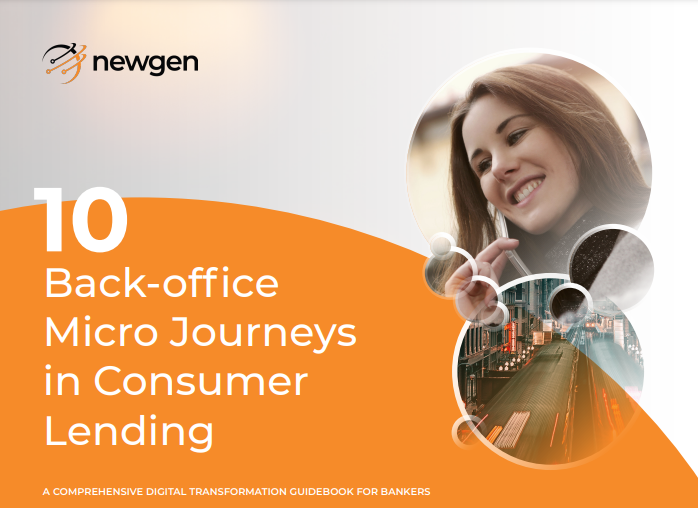Transforming Lending Efficiency, Risk Control, and Compliance Through Digital Micro Innovation
Consumer lending is evolving rapidly. Borrowers expect fast decisions, seamless onboarding, and a digital experience from start to finish. For banks, however, delivering this level of service depends heavily on the operational engine that works behind the scenes — the back office. Traditionally underestimated, back-office operations are now recognized as a strategic advantage that drives responsiveness, regulatory strength, and profitability. This eBook brings attention to the powerful impact of optimizing micro journeys to unleash efficiency, accuracy, and resilience across lending operations.
Why Back-Office Transformation Matters?
Banks face a fast-paced lending landscape with higher loan volumes, heightened credit scrutiny, and ongoing regulatory updates. Legacy processes and disconnected systems create delays that affect everything from underwriting approvals to loan disbursements. A single bottleneck can slow down the entire customer journey.
A future-ready back office strengthens:
- Operational efficiency through automation
- Risk management with real-time insights
- Compliance readiness with accurate documentation
- Customer experience through faster outcomes
A digitally modernized back office becomes a core driver of lending success rather than a cost center.
Micro Journeys: The Building Blocks of Lending Excellence
Instead of trying to transform the entire lending lifecycle at once, high-performing banks break it down into micro journeys. These smaller, targeted processes represent high-impact opportunities for automation.
Examples include:
- Underwriting and risk evaluation
- Pricing decisions
- Fraud prevention
- Vendor management
- Loan servicing and collections
Optimizing these building blocks generates measurable improvements without the risk of full-system disruption.
Ten High-Value Micro Journeys That Unlock Transformation
The eBook highlights ten journeys that define efficiency, risk control, and compliance strength within consumer lending.
- Automated Underwriting and Decisioning
Manual risk checks slow approvals and lead to inconsistencies. Intelligent decision engines analyze data in real time and apply policies uniformly. For complex scenarios, rules-based routing allows experts to intervene with the right context at hand. Faster, more accurate assessment improves credit quality and turnaround.
- Risk-Based Pricing Optimization
Pricing decisions must balance profitability with fair lending obligations. Machine learning models generate competitive rate recommendations based on market patterns and borrower risk. Financial institutions gain confidence in pricing strategies that protect both margin and customer trust.
- Regulatory Compliance Checking
Compliance demands continuous validation of disclosures, fair lending, documentation, and servicing rules. Automated checks limit exposure to costly penalties. Centralized audit tracking preserves evidence across all transactions and simplifies regulatory review.
- Exception Handling and Resolution
Even with strong automation, exceptions occur. Intelligent workflows classify and route exceptions with urgency-based escalation. Documented decisions reduce ambiguity and support oversight teams, enhancing governance and portfolio stability.
- Fraud Detection and Prevention
Digital lending models require advanced protection from identity misuse and coordinated fraud attacks. AI-driven monitoring detects anomalies and prevents approval of suspicious applications. Behavioral and network-based analytics strengthen security without adding friction to legitimate borrowers.
- Loan Closing and Disbursement
Coordinating approvals, payments, and reconciliation can be time-consuming. Modern systems automate fund release through secure channels and confirm accuracy instantly. Customers receive their approved funds faster, strengthening brand trust.
- Collateral Valuation and Management
Managing ongoing collateral quality requires real-time insight. Automated valuation tools and workflow checks ensure accurate loan-to-value tracking and proactive action when portfolio risk changes.
- Loan Portfolio Analytics and Credit Bureau Reporting
Fragmented systems limit performance visibility. Consolidated data analytics enable confident understanding of risk, revenue, and customer behavior. Automated reporting ensures accuracy in credit bureau submissions and mitigates compliance issues.
- External Party Collaboration
Working with appraisers, title agencies, insurers, and more creates complexity. Vendor portals streamline coordination, track deliverables, and enforce service standards while maintaining data control.
- Loan Servicing and Collections Management
Servicing determines long-term customer satisfaction and portfolio performance. Automation supports timely payment handling, better support interactions, and early identification of delinquency risks.
Operational Impact Across the Lending Lifecycle
Digitally optimized micro journeys contribute to powerful benefits:
- Significant reduction in application-to-disbursement cycle time
- Lower operational cost through reduced manual work
- Strong risk posture with consistent decisioning
- Better preparedness for evolving regulatory expectations
- Improved transparency and tracking for leadership oversight
A transformed back office elevates both business outcomes and borrower loyalty.
How to Prioritize Which Micro Journeys to Modernize First?
Every bank has its own challenges. The optimal journey roadmap depends on:
- Risk objectives and credit mix
- Current digital maturity
- Workforce capability
- Regulatory complexity
- Customer service commitments
Leaders can score each micro journey by value impact and ease of implementation to define a phased, efficient transformation program.
A Strategic Framework for Success
Banks that excel in digital execution follow a structured approach:
- Identify micro journeys with measurable bottlenecks
- Standardize workflows across branches and markets
- Automate intelligently with AI-powered tools
- Improve continuously through real-time analytics
- Scale change across products and segments
Small enhancements create momentum for broader modernization.
The Back Office as a Competitive Accelerator
A faster loan turnaround and stronger compliance posture are not advantages that remain unseen. They directly drive business growth. When risk review accelerates, customers complete their journeys with confidence. When fraud is caught earlier, loss avoidance improves. When servicing is smooth, lifetime value expands.
Investment in back-office digitalization unlocks meaningful differentiation in a crowded market.
The Role of Newgen in Micro Journey Modernization
Newgen helps banks bring intelligence, integration, and automation into every back-office journey. By connecting processes, content, and data, the platform supports quicker decisions, consistent governance, and scalable transformation. Banks build operational agility that supports lending growth today and future-proofs against tomorrow’s challenges.
With modernization, back-office excellence becomes a reliable business advantage.
Ready to Accelerate Consumer Lending Performance
Consumer lending success is built on the strength and intelligence of the systems behind the scenes. Transforming back-office micro journeys ensures faster decisions, safer growth, and better borrower outcomes. Every improvement takes the bank one step closer to a complete digital lending future that is resilient, efficient, and customer-first. The time to strengthen lending operations and unlock potential is right now.

